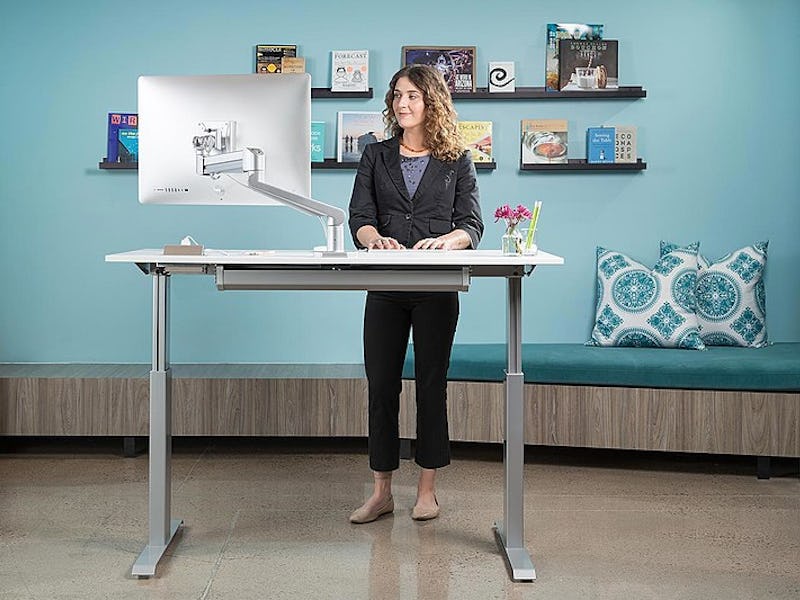Depending on Your Body Type, a Standing Desk May Offer a Useful Health Boost
Are you a "saver" or a "spender"?

If sitting all day is as terrible for our health as it appears to be, then the standing desk is here to deliver us from harm. Standing all day can help the body work just a little bit harder to stave off some of sitting’s costs, but a new analysis published Wednesday in the open-access journal PLOS One suggests that some people may benefit more from a standing desk than others.
Everyone’s body uses energy a little bit differently, but this paper shows that when it comes to transitioning between sitting and standing, people can be grouped into two categories: spenders and savers. In a sample of 55 “young adults,” study author Francisco José Amaro-Gahete, a Ph.D. student at theUniversity of Granada, showed that spenders’ bodies tend to work far harder when they’re standing compared to when they’re sitting. Savers, on the other hand, see either small changes or no change at all between sitting and standing.
“‘Spender’ refers to individuals with a significant rise in energy expenditure, for example, more than 5% between two different positions (lying vs. sitting or sitting vs. standing), and ‘saver’ refers to those who showed no change in energy expenditure between two specific positions,” Amaro-Gahete tells Inverse.
The vast majority of people in his sample were savers: 81 percent, to be exact.
"Savers" in Amaro-Gahete's study expended less energy when they transitioned from sitting to standing compared to "spenders" who saw a bigger change in energy expenditure.
Amaro-Gahete noted these big differences between savers and spenders when he measured several different aspects of energy expenditure, including heart rate and calorie burning, when his participants reclined, sat, and stood for 15 minutes. When people stood, they burned an average of 1.3 calories per minute, compared to about 1.2 in both siting and lying positions. From all metrics taken together, he estimates that standing was associated with approximately a 10 percent increase in energy use.
But when he looked more carefully at individuals in his sample, he saw that increases in energy use due to standing varied widely from person to person.
“The results of our study suggest that this phenomenon does not happen in all persons,” he says. And that difference led him to outline these two categories: savers and spenders.
When spenders transitioned from sitting to standing, they actually expended .8 percent less energy on average. When spenders transitioned from sitting to standing, on the other hand, they expended roughly 8.5 percent more energy. Similar patterns held true for when savers and spenders transitioned from lying down to sitting up, or from lying down to standing up.
So what exactly makes a saver and a spender? Amaro-Gahete admits that we’re still unsure, and that future studies will need to look into “biological factors,” age, or health status that might influence this dichotomy. But based off another one of his findings, he does have an early idea of a place to start looking.
“It seems clear that the lean body mass plays an important role on this relationship,” he says.
In additional measurements, he noted that high percentages of lean body mass were associated with less energy expenditure in sitting, compared to standing — though the changes were small. By comparison, he explains that people with lower percentages of lean body mass seemed to see bigger shifts in energy when they changed positions.
“In this sense, our study supports the argument that individuals with lower lean body mass have lower energy expenditure in resting condition (i.e. lying position), but show higher energy expenditure differences considering sitting vs. standing position because they have a poorer energy expenditure efficiency,” he says.
This strange correlation seems to come down to efficiency of energy expenditure related to lean body mass, Amaro-Gahete explains. Someone with low lean body mass may work less efficiently to keep themselves in the same position compared to someone with a higher percentage of lean body mass. That inefficiency leads to more energy expenditure from just standing around.
However, the lean body mass hypothesis to explain the difference between the “saver” and “spender” dichotomy is still in its early stages. In the paper, they write that “mechanism by which the large majority of participants appear to be spenders remains to be elucidated.”
Still, there are considerable psychological benefits to standing or even getting outside, no matter how hard your body has to work to do it. Regardless of whether you’re a spender or a saver, walking away from the screen can go a long way.
Abstract: The time spent in sedentary behaviour represents an important public health burden. To reduce sedentary time in the general population, the simplest, most effective, and most accessible method is to decrease lying and sitting time. We aimed to compare differences on energy expenditure (EE) across lying, sitting, and standing positions; and to analyse the associations between the change on EE of changing from one position to another and anthropometric and body composition parameters in young healthy adults. A total of 55 (69% women) young healthy adults aged 21.7 ± 2.2 participated in the study. We measured EE by indirect calorimetry across lying, sitting, and standing positions following the standard procedures. The EE was significantly higher in standing than in both lying and sitting positions (mean difference: 0.121±0.292 and 0.125±0.241 kcal/min, respectively; all P0.321). Our findings support the fact that increasing the time spent standing could be a simple strategy to slightly increase EE. Therefore, our results have important clinical implications including a better monitoring, characterizing, and promoting countermeasures to sedentariness through low-level physical activities.